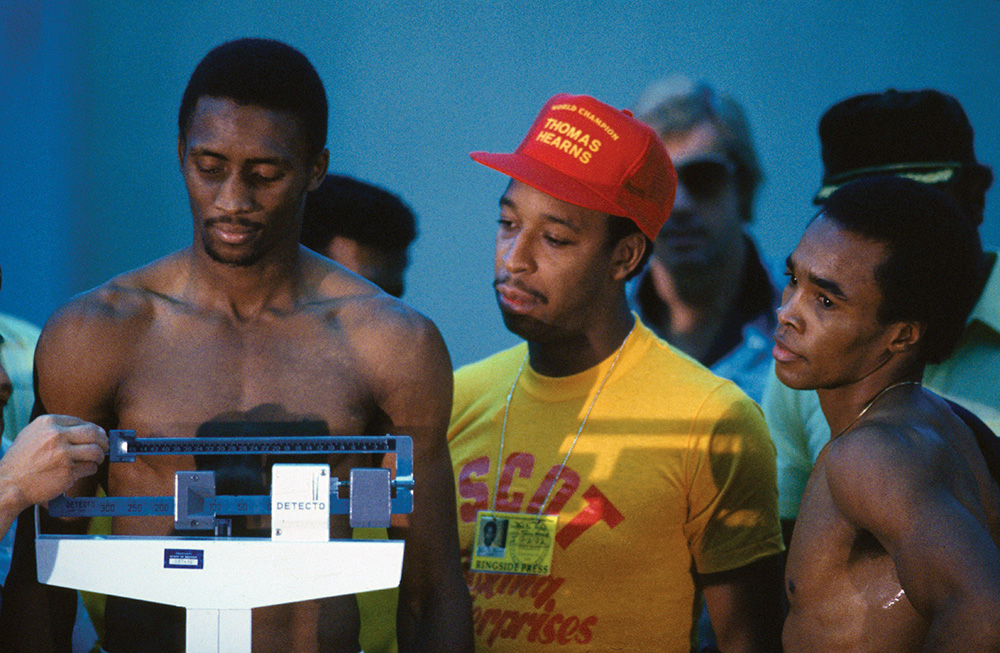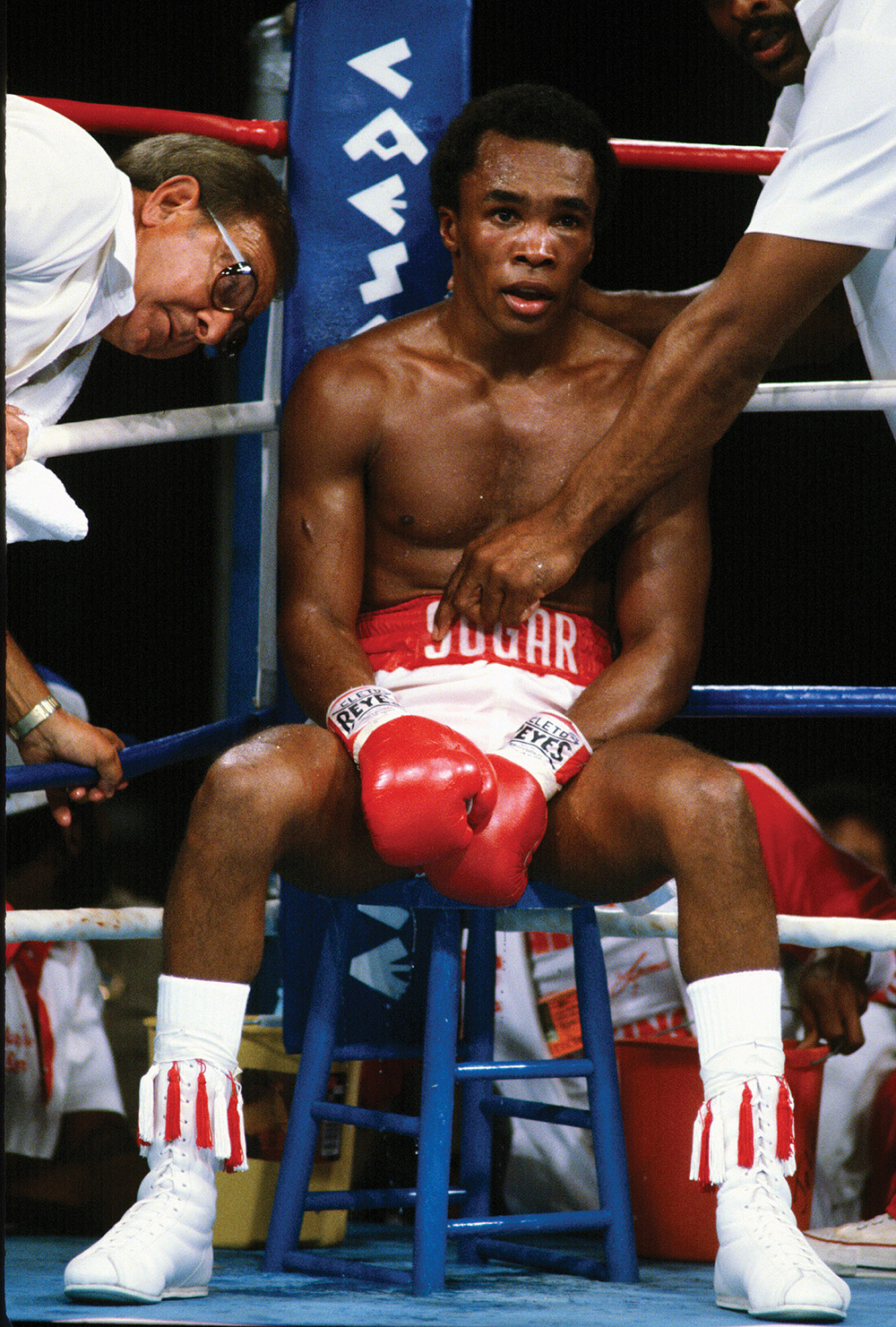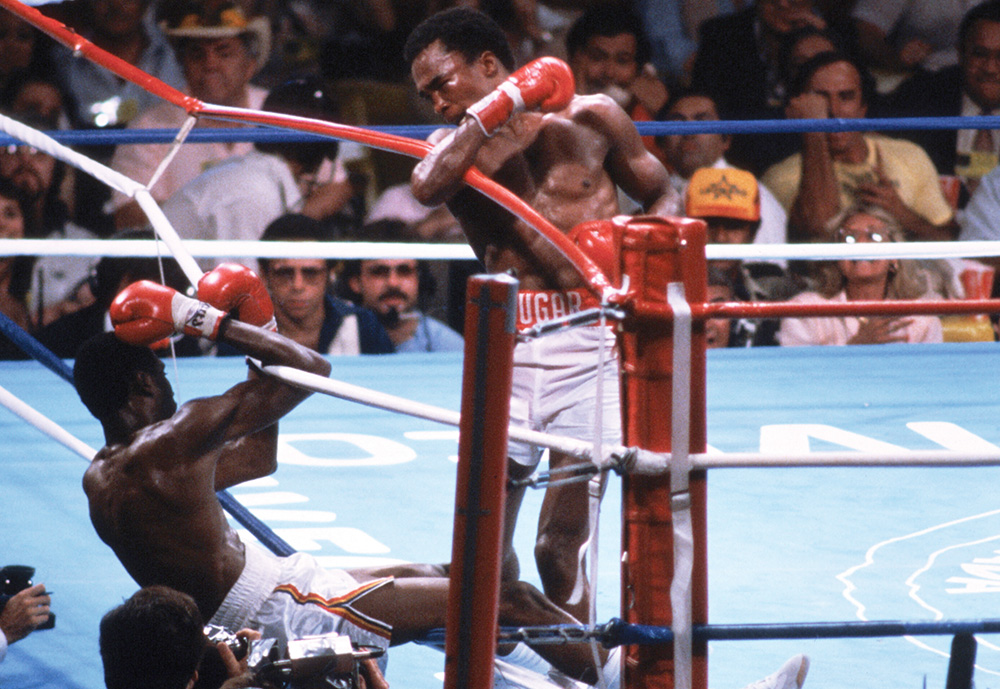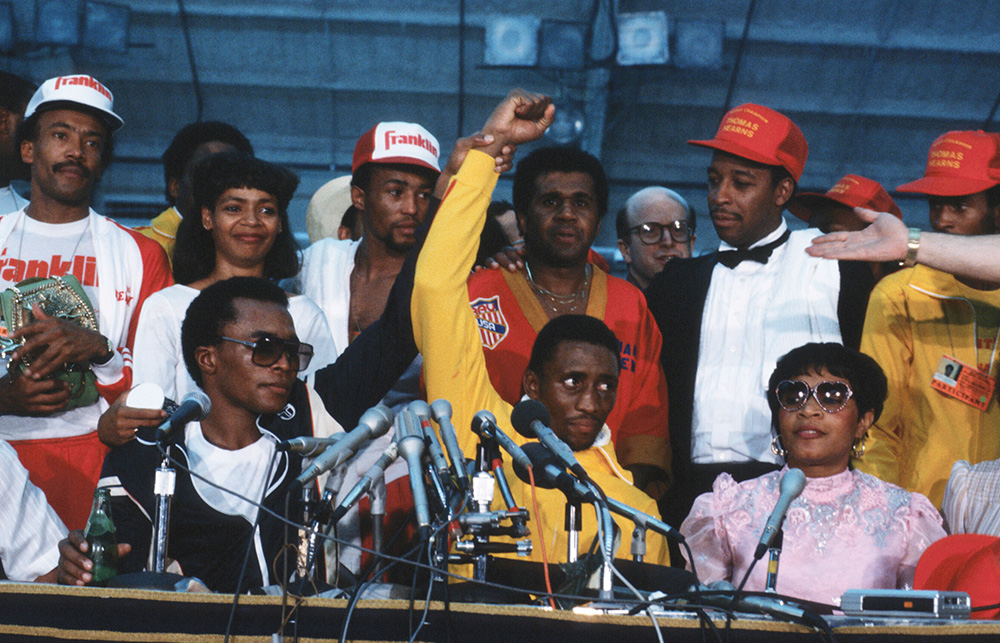Leonard-Hearns: Showdown at the Palace

Editor’s Note: This feature originally appeared in the November 2021 issue of The Ring, which is available for purchase at The Ring Shop.
SUGAR RAY LEONARD’S EPIC BATTLE WITH THOMAS HEARNS REMAINS THE STANDARD BY WHICH ALL WELTERWEIGHT CHAMPIONSHIPS ARE MEASURED
Leonard: “Thomas Hearns has a great body until it gets to the top of his head; he has no brains.”
Hearns: “All your soft-drink commercials are going down the drain.”
The buildup to the undisputed welterweight championship bout between Sugar Ray Leonard and Thomas Hearns, dubbed “The Showdown,” perhaps threatened to get ugly but was largely respectful. This fight didn’t get made because there was bad blood. This fight didn’t get made because it was convenient for TV networks and promoters. The fight got made because both men were obsessed with being the best – it was an inevitable matchup and nothing was allowed to get in the way.
Imagine that!
Leonard (30-1, 21 knockouts), 25, was an Olympic champion with a movie star exterior, massive commercial appeal and otherworldly talent. The Palmer Park, Maryland, resident had ridden the crest of a wave since turning professional in February 1977 and was a household name before lifting Ring and WBC welterweight titles from the previously unbeaten Wilfred Benitez in November 1979. Leonard lost his own unbeaten record to the legendary Roberto Duran in a classic encounter in June 1980 but settled the score in a direct rematch
The 22-year-old Hearns (32-0, 30 KOs) entered the professional ranks in November 1977 in relative obscurity. However, a string of spectacular knockouts – 17 straight – in and around his home city of Detroit transformed the freakishly tall knockout artist into a lucrative fistic franchise. Before he’d won the WBA welterweight title with a violent second-round knockout of long-reigning champ Pipino Cuevas in August 1980, Hearns had sold out every major arena in the Motor City.

Hearns came in well below the welterweight limit, but did the decision to go light cost him?
Three months prior to their superfight, both men scored stoppage wins on the same card in Houston, Texas. Leonard picked up the Ring 154-pound championship and a WBA belt with a stoppage triumph over underrated southpaw Ayub Kalule, and Hearns blasted out the overmatched Pablo Baez in his third title defense.
It was now time for the perfect welterweight storm.
Opinion was divided on the outcome. In a poll conducted in the September 1981 issue of The Ring, 13 experts favored Leonard, 11 went for Hearns and 13 refused to pick a winner. By fight time, Hearns was a slight favorite at 7-to-5, although the odds probably slanted in favor of “The Hitman” due to the huge amount of money coming in from loyal Detroit fans, many of whom had descended on Las Vegas in the hope of seeing their man vanquish Sugar Ray in style.
On Wednesday, September 16, 1981, at a temporary arena erected outside Caesars Palace, two outstanding champions – both in their respective primes – entered the ring … and the world stopped.
SUGAR COATED
“The bell rang and – oh, what feints! What speed! Between the first and second rounds, I noticed the studious eyes of [Muhammad] Ali. He had the same look on his face a law professor might wear while sitting in the back of a mock court as his protégés argued cases brilliantly.”
This was how the late, great sportswriter Ralph Wiley, who was stationed ringside, recalled the opening three minutes of “The Showdown” in his 1989 book Serenity. Leonard was as sure of himself off the back foot as Hearns was coming forward, and both men released punches with incredible speed and confidence. It was boxing at its best. As the bell rang to end that session, Leonard pushed Hearns’ face to the side and an enraged Hitman responded with a short right to the face before being ushered back to his corner by diminutive referee Davey Pearl.
Don’t fool around with me, Ray!
Over the next four rounds, Hearns put on a clinic. Leonard kept on the move, but his head was continually snapped back by a lance-like jab, and the ominous threat of the Detroit man’s right hand bombing – for the most part – kept Sugar Ray at safe distance. Leonard’s skill level was so respected that few experts had predicted that Hearns could win a boxing match, but one or two things had been ignored. Firstly, Hearns had a seven-and-a-half-inch reach advantage (78 to 70½), and his official three-inch height edge (6-foot-1 to 5-foot-10) was probably larger (having met Ray on three occasions, I’d say a touch over 5-foot-8 was more accurate.) However, despite the gangly Hearns being gifted by Mother Nature, he also had incredible hand speed and ring craft.

Hearns’ huge advantages in height and reach kept Leonard from getting off for long periods. (Photo by Dirck Halstead/Liaison)
“It was discouraging to say the least,” Leonard once told me of his early-round plight. “I was really impressed in the ring, and I was just trying to catch up with him. Tommy was outboxing me, giving me angles, and I was saying to myself: ‘Who is this guy?’ I knew Tommy could box, but I didn’t know he could box that well.”
Leonard had fallen way behind, but the experience he’d gained in fights with Benitez and Duran would prove to be a major asset. Benitez was a defensive wizard who forced Leonard to execute on a technical level not previously required, while Duran got inside Leonard’s head, challenged his manhood, hurt him physically and handed him his first professional loss. Five months after that setback, Sugar Ray would prove to the world that he could overcome adversity by befuddling the great Duran in the “No Mas” rematch and forcing him to quit.
Now, against Hearns, Leonard had just 30 minutes to save the day.
HEARNS ON THE HOOK
The Hitman’s gun suddenly jammed with a minute remaining in the sixth. The momentum of a missed overhand right by Leonard brought his own head to waist-level, and as Hearns attempted to counterpunch down, his rival sprung up with a ferocious left hook to the jaw. The punch had an immediate effect, and Sugar Ray went to work. Having waited this long to hurt his man, Leonard’s killer instinct meter was at maximum. There was no time for bolo punches, shoe-shine flurries or Ali shuffles – every shot Leonard threw was a bomb, and he judged the distance of his attack perfectly. Instead of being on the end of Hearns’ long levers, he was now just a touch inside of them. That positioning took away Hearns’ vaunted punching power, but it also meant that Leonard had enough room to unload his entire repertoire on an injured fighter. Hooks and uppercuts to the head kept Hearns woozy, but a brutal left hand to the body almost snapped him in half before the bell.
Leonard was on the ascent and The Hitman was now the hurt man.
“We doctored [Tommy] up, put some ice [on him], brought him back as quick as we could and sent him out there … for some more damage,” recalled Hearns’ cutman, Don Thibodeaux, somewhat soberly in an HBO interview in 2001. “Tommy was in so much pain, I don’t know how he stayed on his feet; I really don’t.”
The seventh round was worse. A cerebral warrior, Leonard now knew that the key to victory was taking the fight to Hearns. Sugar Ray marched across the ring confidently and closed the gap in an instant. He thumped the jab into Hearns’ face, picked off the weaker blows coming back and slammed home hard hooks to the body. When Hearns dropped his hands to protect an already damaged midsection, Leonard released volleys of spectacular headshots that drove his stricken foe backward. It was three minutes of brutal punishment for the man from Detroit.
A cerebral warrior, Leonard now knew that the key to victory was taking the fight to Hearns.
“I’m gonna stop the fight,” barked Emanuel Steward after Hearns staggered back to his corner and slumped on to his stool, looking every part the beaten man.
“No, don’t stop it,” slurred Hearns through a thick fog of breathlessness and pain.
“But you ain’t punching, man. I’m gonna have to stop it if you don’t punch!”
In the immediate aftermath of the fight – and in the decades that followed – there’s been some debate as to how the sixth and seventh rounds were scored. Hearns had won four of the first five rounds on two judges’ scorecards and all five rounds on the other by a 10-9 margin. The Hitman was awarded those sessions because he’d controlled distance, outboxed his man and scored with the sharper blows. Leonard, however, inflicted significant damage in the sixth and seventh, and despite taking punches back, his dominance was clear. Las Vegas officials Duane Ford, Lou Tabat and Chuck Minker scored those rounds 10-9 Leonard, but should they have been scored 10-8?
“You can have a 10-8 round without a knockdown,” offered veteran Las Vegas judge Dave Moretti, a highly respected official with over 40 years of experience. “One fighter has to give the other guy a pretty bad beating; he’s got to be in total control of the round, total dominance, but it’s up to the judges to decide that. I wouldn’t go against what the judges saw that night. It’s a very hard job, and if that’s what they saw, then that’s the end of it.”
I asked Moretti if the 10-point must system should be more flexible in the modern game. Is it fair – or sensible – to give a fighter the same score (10-9) for inflicting brutal punishment in a three-minute period as you would give a fighter who edges a round that’s largely devoid of action?
“I can only go by what they give me to work with,” countered Moretti immediately. “You’ve got to understand, each round is a fight. There’s 12 fights in there (15 in the case of Leonard-Hearns), not just one. One of the fighters gets a 10 and the other fighter gets nine or less. I’ve scored rounds 10-8 without a knockdown, no doubt about it. It doesn’t happen a lot, it’s not a frequent occurrence, but it does happen.”
MAY I HAVE THIS DANCE?
Hearns had never been seriously hurt in a professional fight before. In his biggest test, he’d bludgeoned Cuevas to defeat inside six minutes and left the ring without a scratch. The Hitman had only been extended beyond eight rounds on four previous occasions, and in his longest outing to that point, a 12th-round stoppage of durable Californian Randy Shields, he’d won almost every minute of the fight.
But while there was no pro experience to draw upon in this situation, Hearns always had the facility to revert back to his amateur days, and he now did so at the behest of Steward. In the unpaid ranks, Hearns had the reputation of a fluid boxer-mover who was quick and hard to catch. He went an eye-popping 155-8 as an amateur but produced very few stoppages. Still ahead on all three scorecards, Hearns didn’t need to stop Leonard; what he needed to do was re-establish command and stop his rampaging opponent from getting set.
In the eighth round, Hearns came out to box and move, and while he lost the session on two of the judges’ scorecards, those three minutes were like gold dust for the Detroit star. Hearns regained his senses and got his legs back, while Leonard couldn’t land with the same authority. The roles now completely flipped with the puncher assuming the role of dancer and the dancer assuming the role of puncher.
With his left eye rapidly swelling, Leonard could barely land a blow on this near-invisible version of Hearns, but he wasn’t expending anywhere near the same energy in the desert heat – estimated to be 90 degrees or more under the lights – as his fleet-footed foe. That would prove to be crucial. In the early 1980s, weigh-ins took place on the same day as the fight. The lanky Hearns had come in at 145 pounds, his lightest weight in over two years, and to move and box in the second half of a 15-rounder with resources depleting is a huge ask. Leonard, who had weighed in at a comfortable 146, knew intrinsically that Hearns would tire. “The Sugar Man” may have been losing rounds, but he was making Hearns work extremely hard to win them.

With his left eye badly swollen and time running out, Leonard knew he needed the big finish. (Photo by Focus on Sport/Getty Images)
What if Hearns, like today, had the benefit of a full day or more to rehydrate? What if he’d carried a significant weight advantage into the ring? What if he had that extra fuel to burn?
“Revisionist history is always 100 percent,” said venerable Philly boxing trainer Stephen Edwards. “I don’t think it was much of a factor, to be honest with you. Hearns was a big guy and he was making 147 pounds just fine. He chose to weigh in at 145; it wasn’t a catchweight.
“Hearns was great at 154 and 160, but he was never as dominant as he was at 147. People remember the Duran knockout, but Hearns was taken the distance quite often above welterweight. He went the distance with Ernie Singletary in his next fight. Murray Sutherland. I do believe Emanuel Steward when he said that Hearns was overdoing it in training for Leonard, doing extra runs, but that’s part of the fight game, not to overdo it. As time goes by, people often look for reasons as to why this guy or that guy won. But as great a fighter as Hearns was, Leonard always had better stamina. Leonard still had better stamina when Hearns was the much bigger and stronger guy in the rematch in ’89. If you remember, Hearns was holding on at the end of that fight.”
LEONARD LIGHTNING
As Leonard sat on his stool at the end of the 12th round with his left eye almost completely closed, legendary trainer Angelo Dundee decided to make the switch to motivator. Tactics no longer mattered.
“You’re blowin’ it, son” is perhaps the most oft-quoted phrase uttered by a trainer in boxing history, but there was more than that during this 60-second interval. Dundee also stressed urgency with his body language; he told Leonard that he had “nine minutes” and that he had to “separate the men from the boys.” But just before Leonard stood up to contest arguably the greatest round he ever fought, Dundee got right in his ear: “C’mon, Ray, you’ve gotta be quicker; you’ve got to take it away from him, OK?” Following a brief delay, Dundee then yelled, “Speed!”
Halfway through the 13th round, Leonard nailed his man with a perfect one-two. Had it been earlier in the fight, Hearns could probably have absorbed those strikes and fired back, but with the damage he’d already accrued, his tank almost empty and a great fighter on the attack, the WBA titleholder now wilted. Dundee had requested “speed” and he got it. Leonard followed up with what was arguably the greatest single assault ever seen in a prize ring: too many punches to count, every target area struck flush in a visceral and merciless display of ferocity. Unable to respond or escape, Hearns ended up through the ropes, near his own corner, and although Pearl called no knockdown, this moment was as crucial as any knockdown Leonard had ever scored. Hearns rose, ran for dear life and even attempted to fire back when forced to, but Leonard would bull his man over for an official knockdown before this brutal round was over.
The sand wasn’t just running out of Hearns’ hourglass. The hourglass had been thrown at a brick wall.

A ferocious attack by Sugar Ray changed both the course of the fight and welterweight history. (Photo by Dirck Halstead/Liaison)
Despite the huge effort of that 13th round, Leonard was now on his second or third wind, pumped full of adrenaline, whereas Hearns looked absolutely spent. In the 14th, Sugar Ray was finding his targets all too often when, with just over a minute gone, he timed his man moving left with a whipping overhand right to the chin. As Hearns’ legs dipped, Leonard’s hands simultaneously rose skyward in celebration. It was now a formality. The Hitman could only hold himself erect while Leonard teed off at will, and Pearl called off “The Showdown” at 1:45 of the penultimate round.
“Hail to the new undisputed welterweight champion of the world, Sugar Ray Leonard,” bellowed famed ring announcer Chuck Hull, officially anointing the winner as an all-time great less than five years after his pro debut.
This superfight was a massive shot in the arm for boxing in 1981, and both men’s reputations were elevated. Over the next decade, Hearns continued to defeat elite-level opposition and, like Leonard, he captured a hoard of world title belts from 154 to 175 pounds. With every bit of success Hearns enjoyed, Leonard’s win over him grew exponentially. Four decades on, “The Showdown” remains the benchmark to which all elite-level welterweight matchups are compared. Oscar De La Hoya and Felix Trinidad didn’t come close to matching it when they met in September 1999. Floyd Mayweather and Manny Pacquiao tickled each other by comparison in May 2015. Politics and egos have prevented Errol Spence and Terence Crawford from even getting in the ring. Another 40 years could go by without Leonard’s triumph over Hearns being equaled or bettered, and no one would be the least bit surprised.
It was undeniably one of the greatest wins in boxing history.

Leonard only had respect and admiration for Hearns following their epic welterweight championship showdown. (Photo by Dirck Halstead/Liaison)
“You have to think about the perception of Hearns before that fight happened,” said Edwards. “In 1981, Hearns is the number one pound-for-pound fighter in the world, and he was also the slight favorite going in. Leonard and Duran had split fights. [Marvelous Marvin] Hagler was a great fighter, but he still hadn’t had the mainstream success that Leonard and Duran had.
“Hearns is 6-foot-1, he’s 32-0 with 30 KOs, and he probably has a case for being the best offensive fighter in the history of boxing at that time … and he’s a physical freak. Even to this day, 40 years later, there hasn’t been a welterweight who would be favored to beat Thomas Hearns – not Floyd Mayweather Jr., not Manny Pacquiao, not Felix Trinidad, not Oscar De La Hoya, not Shane Mosley, not Donald Curry. In fact, in the 30 years before Hearns, there wouldn’t be a fighter favored to beat him at welterweight. You’d probably have to go all the way back to Sugar Ray Robinson.”
On September 16, 1981, in what would later be named The Ring’s Fight of the Year, Ray Leonard proved that “Sugar” was not only a moniker of convenience. The new undisputed champion had fully earned it.
YOU MAY HAVE MISSED
BEST I FACED: SUGAR RAY LEONARD
Want more Leonard and Hearns?
You can find our “Four Kings” special issue in the shop!














